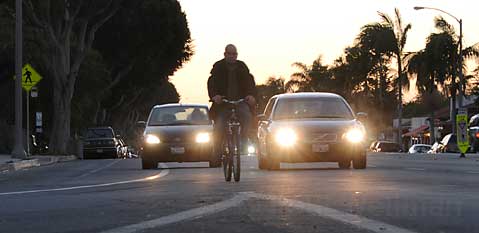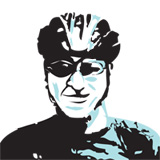Invisible Riders
In More Ways than One

Erika enjoys bird-watching. Cyclist-spotting is not nearly as popular but there are definitely recognizable clans within our larger tribe. Lycra, shaved legs, and fancy carbon bikes are an easy spot around town. You got it – it’s a roadie. Hipster tattoos, fat lock, skinny jeans, and you can check the box next to fixie-rider. If you see surfboards, golden tans, and a whiff of sea salt as they roll by, you can be sure that you’ve spotted a pod of cruisers. There are lots of other bike clans, but most of us don’t see the invisible riders around town. And, I’m not talking just about those nightriders without lights wearing black t-shirts and jeans.
I’m talking about the low-income cyclists who ride to work, school, or shopping, often on a secondhand mountain bike, kid’s bike, or old cruiser. Their daily ride isn’t a choice. They’re riding because it’s the only form of transportation they have. Here in Santa Barbara, many of our invisible riders are Hispanic and live on the Westside or Eastside.

Sergio wakes up early, and starts his 45-minute bike ride to work in Montecito most mornings before dawn. He uses a sturdy hybrid bike for work and errands. However, unlike many invisible cyclists who only ride out of necessity, Sergio also rides a lightweight carbon fiber bike for pleasure. He builds and maintains his bikes at Bici Centro, where he also volunteers to help others learn basic repairs. All too often, his bikes are stolen from behind the small room that he shares with three other men. Sold on the black market for $50 to $60, stolen bikes quickly find new low-income owners who are desperate for transportation.
I have a choice about how I get around town. If it’s raining, I can afford to drive my car to errands in Goleta or a meeting in Summerland, or take a bus. I ride because it makes me feel good. I also know that I’m saving money and energy. I am being an environmentally conscious citizen with a small carbon footprint. Invisible riders aren’t on two wheels to make a personal statement about their values. They ride in the dark, in rain, fog, and cold because they have no other choice.
In 2011, the Bike Coalition’s Spanish Language Outreach Committee interviewed 154 Spanish-speaking riders during its annual Iluminando la Noche bike-light giveaway. Who are they? Most are men. Why do they ride a bike? For 70% of them the primary reason was commuting and work. Another 20% said they use the bike for errands, and the remainder ride to school. None mentioned pleasure or exercise.
The survey also tested their knowledge of basic cycling rules of the road. Almost 60% passed, demonstrating both basic safety skills and an understanding of the rights and responsibilities of a cyclist. In 2012, the Spanish Language Outreach Committee interviewed 450 riders. Annual data collection will make sure that programs and outreach efforts continue to meet the needs of this underserved population.
Most of us think of Santa Barbara as an expensive place to live, with lots of wealthy folks. It’s also a place where poorer people live. Just over 19% of the city’s households were low-income (under $25,000) in 2011, according to the U.S. Census Bureau, with slightly over 14% of Santa Barbarans living below the poverty level. Another 20% of households had incomes between $25,000 and $50,000. At the same time, Hispanics were 38% of the city’s population in 2010 (of the total 88,410 residents, 22,070 of us foreign-born). I’m guessing that the greater part of the 40 percent of households making under $50K are also Hispanic. Demographically at least, invisible riders should be visible in Santa Barbara.
As Sergio pedals to work or rides around town, he’ll stop to help other Hispanic riders whose bikes have broken. Often he shows them how to adjust a derailleur or replace a chain that has fallen off the front chain ring while they are pedaling. Many immigrant riders don’t speak much English and are trying to make themselves invisible to the outside world, making most things, including riding a bicycle in Santa Barbara, more difficult. But Sergio says that it is also safer than in Mexico because of the bike lanes and because drivers here are aware of and watch out for cyclists on the road.
Invisible riders tend to ride alone, often on the sidewalk where they feel safer, and usually without lights, reflective clothing, or helmets. They often:
• Have a limited knowledge of cyclist’s rights due to language barriers and a distrust of government and the police.
• Ride low-cost, poorly fitted, and poorly maintained bikes.
• Have bikes stolen frequently
• Lack health insurance for injuries or accidents.
In 2004, the Federal Highway Administration’s (FHWA) Pedestrian and Bicycle Safety Research Program completed a study that looked at the number of Hispanic’s killed in pedestrian and bicycle accidents. According to the data, there appeared to be a disproportionate number of Hispanic immigrants killed in accidents.
We ride bikes for a lot of different reasons. Most of us choose to ride, whether we’re conquering mountains, commuting to school, losing weight, getting in shape, or riding a Century. I enjoy my bike-centric daily life. For the invisible cyclist, the rain-or-shine trips to work, the market, and school aren’t choice. Sergio is among those who ride from necessity. He’s also trying to help the other invisible cyclists help themselves, by teaching them how to ride safely.
When you’re out riding, give an “Hola!” to invisible riders that you meet. Let’s make every cyclist a visible – and well-lighted – part of our tribe.


